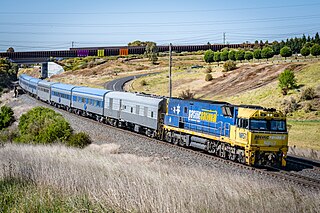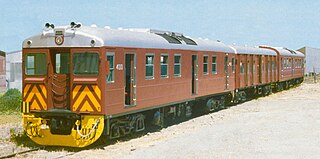
The National Railway Museum (NRM) is a museum in York, England, forming part of the Science Museum Group. The museum tells the story of rail transport in Britain and its impact on society. It is the home of the national collection of historically significant railway vehicles such as Mallard, Stirling Single, Duchess of Hamilton and a Japanese bullet train. In addition, the National Railway Museum holds a diverse collection of other objects, from a household recipe book used in George Stephenson's house to film showing a "never-stop railway" developed for the British Empire Exhibition. It has won many awards, including the European Museum of the Year Award in 2001.

Adelaide railway station is the central terminus of the Adelaide Metro railway system. All lines approach the station from the west, and it is a terminal station with no through lines, with most of the traffic on the metropolitan network either departing or terminating here. It has nine below-ground platforms, all using broad gauge track. The station is located on the north side of North Terrace, west of Parliament House.

The Stony Point line is a commuter railway line in the outer metropolitan area of Melbourne, Victoria, Australia. Operated by Metro Trains Melbourne, it is the city's only diesel service on the metropolitan network and the tenth longest line at 31 kilometres (19 mi). The line acts as an extension of the Frankston line with services running from Frankston station to the small town of Stony Point in the south-east, serving 10 stations via Leawarra, Baxter, Hastings, and Bittern. The line operates for approximately 13 hours a day, unlike other lines on the network, which provide 24-hour service on Friday and Saturday nights. Headways of 90 to 120 minutes are operated throughout the day due to limited patronage and infrastructure constraints. Trains on the Stony Point line run as two one-car formations of V/Line Sprinter DMUs.

The Overland is an interstate passenger train service in Australia, travelling between the state capitals of Melbourne and Adelaide, a distance of 828 km (515 mi). It first ran in 1887 as the Adelaide Express, known by South Australians as the Melbourne Express. It was given its current name in 1936. Now operated by private company Journey Beyond, the train undertakes two return trips a week. Originally an overnight train that stopped at large intermediate stations, it now operates during the day, stopping less frequently.

Locomotive No. 1 hauled the first passenger train in New South Wales, Australia. It was built by Robert Stephenson and Company. In 1846, the Sydney Railway Company was formed with the objective of building a railway line between Sydney and Parramatta. No. 1 was one of four locomotives that arrived by sea from the manufacturer in January 1855. The first passenger train hauled by No. 1 was a special service from Sydney Station to Long Cove viaduct on 24 May 1855, Queen Victoria's birthday.

Serviceton is a town in rural western Victoria, Australia. It is near the Victorian–South Australian border, 437 kilometres north-west of Melbourne. Named after James Service, who was Premier of Victoria in 1880 and from 1883 to 1886, it was established when the inter-colonial railway line between Adelaide and Melbourne was completed in 1887. The railway station served as the change-over point for train crews and locomotives of the Victorian Railways and South Australian Railways.

The Tasmanian Government Railways (TGR) was the former operator of the mainline railways in Tasmania, Australia. Formed in 1872, the railway company was managed by the Government of Tasmania, and existed until absorption into the Australian National Railways Commission in 1978.

The Redhen railcars was the nickname given to the 300 and 400 classes of diesel-hydraulic railcars designed by the South Australian Railways and built at its Islington Railway Workshops between 1955 and 1971. The railcars, which operated in Adelaide suburban service until 1996, remain a nostalgic part of South Australian memory. Some continue to be operated by the SteamRanger Heritage Railway, the National Railway Museum, Port Adelaide and other railway preservation entities.

The Spirit of Progress was the premier express passenger train on the Victorian Railways in Australia, running from Melbourne to the New South Wales border at Albury, and later through to Sydney.

The National Railway Museum, Port Adelaide, South Australia is the largest railway museum in Australia. More than 100 major exhibits, mainly from the South Australian Railways (SAR) and Commonwealth Railways and their successor, Australian National, are displayed at its 3.5 hectares site. A very large archival collection of photographs of those railways and records created by them is also managed by the museum. The museum is operated with a large number of volunteers.

Milang is a town and locality located in the Australian state of South Australia on the west coast of Lake Alexandrina about 71 kilometres (44 mi) south-east of the state capital of Adelaide and about 20 kilometres (12 mi) north-east of the municipal seat of Goolwa.

The Eyre Peninsula Railway is a 1,067 mm gauge railway on the Eyre Peninsula of South Australia. Radiating out from the ports at Port Lincoln and Thevenard, it is isolated from the rest of the South Australian railway network. It peaked at 777 kilometres in 1950; today only a 60 kilometre section remains open. It is currently operated by Aurizon.

Nurragi was an unattended station at the farming locality of the same name in South Australia. It was located on the former 13.1 km (8.1 mi) long Milang railway line, which opened in 1884 and closed in 1970.

The South Australian Railways 350 class comprised two diesel-electric locomotives built by the railway's Islington Railway Workshops, entering service in June 1949. They were the first diesel-electric locomotives built in Australia and the first to be operated by the South Australian Railways.

The Mount Perry Branch Railway is a closed railway line in Central Queensland, Australia. In 1869 copper was discovered at Mount Perry and the township grew rapidly. A railway to the coast was essential to provide cheap transport and make the mining of low percentage ore viable. Maryborough and Bundaberg vied for the opportunity to be the terminus and the latter city was successful.
The Milang railway line was a branch line, now closed, of the former South Australian Railways that left the mainline to Victor Harbor at the farming locality of Sandergrove, 9 km (6 mi) south of Strathalbyn and 89.7 km (55.75 mi) by rail from Adelaide. From there it proceeded in a south-easterly direction for 13.1 km (8.1 mi) to the riverport of Milang on Lake Alexandrina, in the estuary of the River Murray. The line was opened on 17 December 1884; it was formally closed on 17 June 1970. The route is now a "rail trail" that is popular with hikers. The precincts of the former Milang station house a railway museum that includes an innovative locomotive driving simulator for visitors to operate. Onsite is a centre for South Australian historical light railways.

The South Australian Railways A Class locomotives arrived for the South Australian Railways in September and October 1868 from Robert Stephenson and Company. A third and final locomotive was ordered and arrived in 1873, these locomotives were withdrawn between 1893 and 1924 from the SAR after many years of hard service.

The South Australian Railways G Class locomotives first appeared on the South Australian Railways in 1869 after being purchased from Beyer, Peacock and Company. More locomotives were purchased and in service by 1880, and again in 1886. The G class was extinct by 1923.

The South Australian Railways H Class locomotives were built by Robert Stephenson and Company in 1870 for the South Australian Railways. The first of three numbered 25, 26 and 27 were all in service by June 1871. After being a well received class, two more locomotives were ordered and were in service by October 1872. Nos. 30 and 31 arrived in August 1874. The final two locomotives ordered for the SAR arrived in August 1877 and were numbered 2 and 3. These locomotives worked on the SAR system for many years, with only one member of the class being withdrawn in 1888. The rest of the class were rebuilt over the years and lasted well into the next century with, the final locomotive being withdrawn by 1930.

Eighteen South Australian Railways K class (broad-gauge) locomotives were built by Beyer, Peacock and Company for the South Australian Railways (SAR) between 1878 and 1884. Despite having a fundamental design flaw that affected their original role as light-line passenger locomotives, they eventually performed shunting duties exclusively. They operated for six decades.



















